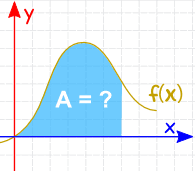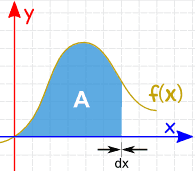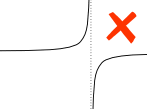How To Find Integral Of A Function
Definite Integrals
You might like to read Introduction to Integration kickoff!
Integration
| Integration can be used to find areas, volumes, central points and many useful things. But it is often used to detect the expanse nether the graph of a function like this: |  | |
| The area can be found by adding slices that arroyo nil in width: And there are Rules of Integration that assistance u.s. get the answer. |  |
Note

The symbol for "Integral" is a fashionable "S" (for "Sum", the thought of summing slices):
After the Integral Symbol we put the office we want to find the integral of (chosen the Integrand).And then finish with dx to mean the slices go in the x direction (and approach zero in width).
Definite Integral
A Definite Integral has commencement and end values: in other words there is an interval [a, b].
a and b (chosen limits, premises or boundaries) are put at the bottom and top of the "S", like this:
We find the Definite Integral past calculating the Indefinite Integral at a, and at b, so subtracting:

Example: What is
We are being asked for the Definite Integral, from ane to ii, of 2x dx
Commencement nosotros need to find the Indefinite Integral.
Using the Rules of Integration we find that ∫2x dx = tenii + C
Now calculate that at one, and 2:
- At x=1: ∫2x dx = 1two + C
- At x=2: ∫2x dx = 22 + C
Subtract:
(ii2 + C) − (ane2 + C)
2two + C − onetwo − C
4 − ane + C − C = iii
And "C" gets cancelled out ... so with Definite Integrals we can ignore C.
Effect:

Bank check: with such a simple shape, let's also try computing the area by geometry:
A = 2+4 2 × 1 = 3
Yes, it does have an area of 3.
(Yay!)
Notation: It is usual to show the indefinite integral (without the +C) inside square brackets, with the limits a and b after, similar this:
Case (continued)
How to prove your answer:
2x dx
= 2two − onetwo
= 3
Let's endeavor some other case:

Example:
The Definite Integral, from 0.5 to 1.0, of cos(ten) dx:
(Notation: x must be in radians)
The Indefinite Integral is: ∫ cos(x) dx = sin(10) + C
We can ignore C for definite integrals (as we saw above) and nosotros get:
cos(x) dx
= sin(1) − sin(0.5)
= 0.841... − 0.479...
= 0.362...
And another example to brand an of import point:

Instance:
The Definite Integral, from 0 to 1, of sin(10) dx:
The Indefinite Integral is: ∫ sin(ten) dx = −cos(x) + C
Since we are going from 0, can we just calculate the integral at x=1 ??
−cos(1) = −0.540...
What? It is negative? Simply it looks positive in the graph.
Well ... we made a mistake!
Considering we need to subtract the integral at x=0. Nosotros shouldn't assume it is zero.
So permit us do information technology properly, subtracting one from the other:
sin(x) dx
= −cos(one) − (−cos(0))
= −0.540... − (−i)
= 0.460...
That'due south better!
But we can have negative regions, when the curve is below the centrality:

Case:
The Definite Integral, from ane to iii, of cos(10) dx:
Notice that some of it is positive, and some negative.
The definite integral will work out the net value.
Permit us exercise the calculations:
cos(x) dx
= sin(three) − sin(1)
= 0.141... − 0.841...
= −0.700...
So there is more than negative than positive with a net result of −0.700....
f(ten) dx = (Expanse above ten axis) − (Surface area below ten axis)
Attempt integrating cos(10) with different start and terminate values to see for yourself how positives and negatives work.
Positive Area
But sometimes we desire all area treated as positive (without the part below the axis being subtracted).
In that case we must summate the areas separately, similar in this example:

Case: What is the total area betwixt y = cos(ten) and the x-axis, from x = 1 to x = iii?
This is like the case nosotros just did, but now nosotros expect that it is all positive (imagine nosotros had to pigment information technology).
So now we have to practise the parts separately:
- Ane for the surface area in a higher place the x-centrality
- One for the expanse beneath the x-axis
The bend crosses the x-axis at x = π/2 so we take:
From 1 to π/2:
cos(10) dx
= 1 − 0.841...
= 0.158...
From π/two to three:
cos(ten) dx
= 0.141... − ane
= −0.859...
That last ane comes out negative, but we want information technology to be positive, so:
Full area = 0.158... + 0.859... = 1.017...
This is very different from the answer in the previous example.
Continuous
Oh yes, the part we are integrating must exist Continuous between a and b: no holes, jumps or vertical asymptotes (where the function heads up/downwardly towards infinity).

Example:
A vertical asymptote between a and b affects the definite integral.
Properties
Surface area above − area below
The integral adds the expanse above the centrality but subtracts the area below, for a "net value":
f(10) dx = (Area above ten axis) − (Expanse below 10 axis)
Calculation Functions
The integral of f+m equals the integral of f plus the integral of g:
f(x) + g(ten) dx =
f(x) dx +
g(x) dx
Reversing the interval

Reversing the direction of the interval gives the negative of the original management.
Interval of nothing length

When the interval starts and ends at the same place, the consequence is nothing:
Adding intervals

We can also add two side by side intervals together:
f(x) dx =
f(10) dx +
f(ten) dx
Summary
The Definite Integral between a and b is the Indefinite Integral at b minus the Indefinite Integral at a.
6864, 6865, 6866, 6867, 6868, 6869, 6870, 6871, 6872, 6873, 6874
Source: https://www.mathsisfun.com/calculus/integration-definite.html
Posted by: hallettpasper.blogspot.com


0 Response to "How To Find Integral Of A Function"
Post a Comment